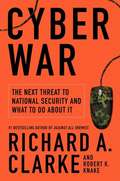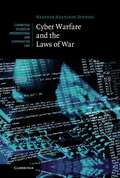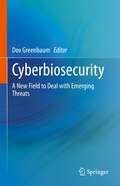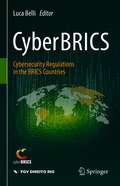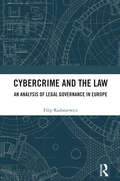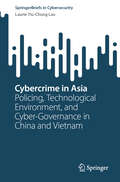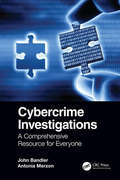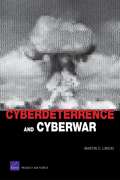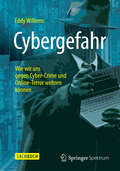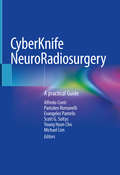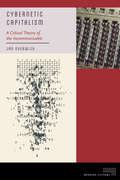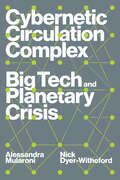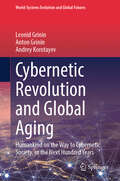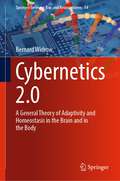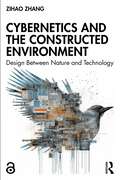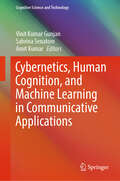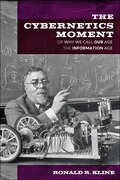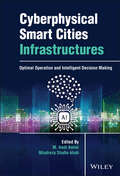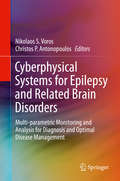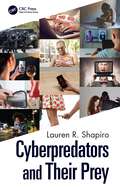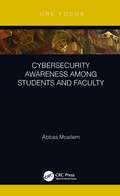- Table View
- List View
Cyber War: The Next Threat to National Security and What to Do About It
by Richard A. Clarke Robert KnakeRichard A. Clarke warned America once before about the havoc terrorism would wreak on our national security--and he was right. Now he warns us of another threat, silent but equally dangerous. Cyber War is a powerful book about technology, government, and military strategy; about criminals, spies, soldiers, and hackers. This is the first book about the war of the future--cyber war--and a convincing argument that we may already be in peril of losing it. Cyber War goes behind the "geek talk" of hackers and computer scientists to explain clearly and convincingly what cyber war is, how cyber weapons work, and how vulnerable we are as a nation and as individuals to the vast and looming web of cyber criminals. From the first cyber crisis meeting in the White House a decade ago to the boardrooms of Silicon Valley and the electrical tunnels under Manhattan, Clarke and coauthor Robert K. Knake trace the rise of the cyber age and profile the unlikely characters and places at the epicenter of the battlefield. They recount the foreign cyber spies who hacked into the office of the Secretary of Defense, the control systems for U.S. electric power grids, and the plans to protect America's latest fighter aircraft. Economically and militarily, Clarke and Knake argue, what we've already lost in the new millennium's cyber battles is tantamount to the Soviet and Chinese theft of our nuclear bomb secrets in the 1940s and 1950s. The possibilities of what we stand to lose in an all-out cyber war--our individual and national security among them-- are just as chilling. Powerful and convincing, Cyber War begins the critical debate about the next great threat to national security.
Cyber Warfare and the Laws of War
by Heather Harrison DinnissThe information revolution has transformed both modern societies and the way in which they conduct warfare. Cyber Warfare and the Laws of War analyses the status of computer network attacks in international law and examines their treatment under the laws of armed conflict. The first part of the book deals with the resort to force by states and discusses the threshold issues of force and armed attack by examining the permitted responses against such attacks. The second part offers a comprehensive analysis of the applicability of international humanitarian law to computer network attacks. By examining the legal framework regulating these attacks, Heather Harrison Dinniss addresses the issues associated with this method of attack in terms of the current law and explores the underlying debates which are shaping the modern laws applicable in armed conflict.
Cyberbiosecurity: A New Field to Deal with Emerging Threats
by Dov GreenbaumBiocybersecurity applies cybersecurity research to the field of biology, and, to a lesser degree, applies biological principles to the field of cybersecurity. As biologists increasingly research, collaborate, and conduct research online, biocybersecurity has become crucial to protect against cyber threats. This book provides an overview of biocybersecurity through the lens of researchers in academia, industry professionals, and government, in both biology and cybersecurity fields. The book highlights emerging technologies, and identifies emerging threats connected with these technologies, while also providing a discussion of the legal implications involved.This book takes on a multidisciplinary approach, and appeals to both professionals and researchers in the synthetic biology, bioinformatics, and cybersecurity fields.
CyberBRICS: Cybersecurity Regulations in the BRICS Countries
by Luca BelliThis book stems from the CyberBRICS project, which is the first major attempt to produce a comparative analysis of Internet regulations in the BRICS countries – namely, Brazil, Russia, India, China, and South Africa. The project has three main objectives: 1) to map existing regulations; 2) to identify best practices; and 3) to develop policy recommendations in the various areas that compose cybersecurity governance, with a particular focus on the strategies adopted by the BRICS countries to date. Each study covers five essential dimensions of cybersecurity: data protection, consumer protection, cybercrime, the preservation of public order, and cyberdefense.The BRICS countries were selected not only for their size and growing economic and geopolitical relevance but also because, over the next decade, projected Internet growth is expected to occur predominantly in these countries. Consequently, the technology, policy and governance arrangements defined by the BRICS countries are likely to impact not only the 3.2 billion people living in them, but also the individuals and businesses that choose to utilize increasingly popular applications and services developed in BRICS countries according to BRICS standards. Researchers, regulators, start-up innovators and other Internet stakeholders will find this book a valuable guide to the inner workings of key cyber policies in this rapidly growing region.
Cybercrime and the Law: An Analysis of Legal Governance in Europe
by Filip RadoniewiczThis book provides a comprehensive and synthetic analysis of the legal acts of the Council of Europe and the European Union affecting regulation of cybercrime in EU countries. Technical aspects relating to cybercrime are also discussed. The work explains core ideas, including background, nomenclature, a definition of computer crime and a history of its criminalisation. It examines the Council of Europe’s Convention on Cybercrime, the first international law act governing the subject, and the additional Protocol to the Convention on Cybercrime, dealing with the criminalisation of computer-generated racist and xenophobic acts. The volume discusses European Union regulations, including applicable European Union laws on cybercrime such as the Council Framework Decision 2005/222/JHA and Directive 2013/40/EU on attacks against information systems, and Directive 2011/93/EU on Combating the Sexual Abuse and Sexual Exploitation of Children and Child Pornography. Finally, the work explores issues of cyberterrorism including the dissemination of terrorist content online. The book will be a valuable resource for academics, researchers and policy-makers working in the areas of criminal law, IT law, EU law and cyber security.
Cybercrime in Asia: Policing, Technological Environment, and Cyber-Governance in China and Vietnam (SpringerBriefs in Cybersecurity)
by Laurie Yiu-Chung LauThis work examines the most pressing and contentious issues in cybercrime currently facing the China and Vietnam, and how best to tackle them. The text sets the context for how blocs of nations (including the least ready, the most ready, and those occupying a central position in terms of cybercrime readiness) react to the evolving challenges of cybercrime, with a focus on prevention and control. In this way, the work discusses why certain blocs of nations in the Asia-Pacific region are not at an optimal level of cybercrime readiness despite the rapid pace of technological advancement in this region, and how such nations can become regional leaders in cybercrime readiness.
Cybercrime Investigations: A Comprehensive Resource for Everyone
by John BandlerCybercrime continues to skyrocket but we are not combatting it effectively yet. We need more cybercrime investigators from all backgrounds and working in every sector to conduct effective investigations. This book is a comprehensive resource for everyone who encounters and investigates cybercrime, no matter their title, including those working on behalf of law enforcement, private organizations, regulatory agencies, or individual victims. It provides helpful background material about cybercrime's technological and legal underpinnings, plus in-depth detail about the legal and practical aspects of conducting cybercrime investigations. Key features of this book include: Understanding cybercrime, computers, forensics, and cybersecurity Law for the cybercrime investigator, including cybercrime offenses; cyber evidence-gathering; criminal, private and regulatory law, and nation-state implications Cybercrime investigation from three key perspectives: law enforcement, private sector, and regulatory Financial investigation Identification (attribution) of cyber-conduct Apprehension Litigation in the criminal and civil arenas. This far-reaching book is an essential reference for prosecutors and law enforcement officers, agents and analysts; as well as for private sector lawyers, consultants, information security professionals, digital forensic examiners, and more. It also functions as an excellent course book for educators and trainers. We need more investigators who know how to fight cybercrime, and this book was written to achieve that goal. Authored by two former cybercrime prosecutors with a diverse array of expertise in criminal justice and the private sector, this book is informative, practical, and readable, with innovative methods and fascinating anecdotes throughout.
Cyberdeterrence and Cyberwar
by Martin C. LibickiCyberspace, where information--and hence serious value--is stored and manipulated, is a tempting target. An attacker could be a person, group, or state and may disrupt or corrupt the systems from which cyberspace is built. When states are involved, it is tempting to compare fights to warfare, but there are important differences. The author addresses these differences and ways the United States protect itself in the face of attack.
CyberForensics: Understanding Information Security Investigations (Springer’s Forensic Laboratory Science Series)
by Jennifer BayukThis fascinating and highly topical subject has a history dating back to the secret world of 1970s Cold War espionage, when the US military and Central intelligence agencies, aided by the latest mainframe systems, were the first to use computer forensics techniques in counterintelligence. In the decades since, cybercrime has emerged from the obscurity of low-level prosecution evidence to become a serious cross-border crime issue, while cyberforensic investigators have moved on from drug, murder, and child pornography crimes that were facilitated by computers, and are now tackling headline-grabbing cyber bank robbery, identity theft, and corporate spying. With little consensus as yet on the qualifications required to become a cyberforensic investigator, Cyberforensics: Understanding Information Security Investigations assembles the varying perspectives of pioneers and key figures in the field. All the authors have more than 10 years' experience in successfully investigating cybercrime, and some more than 20. Through real-life case studies the chapters introduce the reader to the field of cybersecurity, starting with corporate investigation, and progressing to analyze the issues in more detail. Taking us from accounting cyberforensics to unraveling the complexities of malware, the contributors explain the tools and techniques they use in a manner that allows us to map their methodology into a more generic understanding of what a cybersecurity investigation really is. Above all, Cyberforensics shows that there is a cohesive set of concepts that binds cybersecurity investigators to a shared vision. These core ideas are now gaining importance as a body of knowledge that cyberforensics professionals agree should be a prerequisite to the professional practice of information security.
Cybergefahr: Wie wir uns gegen Cyber-Crime und Online-Terror wehren können
by Eddy WillemsMan kann online wählen, Rechnungen bezahlen und Tickets kaufen - aber wie sicher ist das? Überall lauern Viren, Spam, Hackerangriffe und sogar Cyber-Spione. Wie kann man sich schützen und wie sollte man dem Phänomen Cyber-Crime begegnen? Der bekannte Security-Experte Eddy Willems gibt einen Überblick über Online-Gefahren und Möglichkeiten, sich vor ihnen zu schützen. Er erläutert spannend die Vergangenheit, Gegenwart und Zukunft des Cyber-Crime.
Cyberia (Cyberia #1)
by Chris LynchZane lives in a completely wired world where every pet has a microchip that allows it to talk. Zane soon learns that the pets aren't actually saying what the chip is translating. They aren't happy that all animals have been domesticated, and they enlist Zane to help them fight back and ensure their freedom.
CyberKnife NeuroRadiosurgery: A practical Guide
by Alfredo Conti Pantaleo Romanelli Evangelos Pantelis Scott G. Soltys Young Hyun Cho Michael LimThis book is a practical guide on image-guided robotic (CyberKnife®) radiosurgery of the brain and the spine. The volume introduces the radiosurgical community to the potential of image-guidance in the treatment of neurosurgical diseases including neuro-oncological, vascular and functional disorders. Principles of image-guided radiosurgery, including physics and radiobiology are considered. Each chapter provides a critical review of the literature and analyses of several aspects to offer an assessment of single and hypofractionated treatments. Based on the authors’ experience, tables or summaries presenting the treatment approaches and associated risks are included as well. Providing a practical guide to define the selection of dose, fractionation schemes, isodose line, margins, imaging, constraints to the structures at risk will support safe practice of neuroradiosurgery. This book aims to shed new light on the treatment of neoplastic and non-neoplastic diseases of the central nervous system using the CyberKnife® image-guided robotic radiosurgery system. It will be adopted by neurosurgery residents and neurosurgery consultants as well as residents in radiation oncology and radiation oncologists; medical physicists involved in radiosurgery procedures may also benefit from this book.
Cybernetic Capitalism: A Critical Theory of the Incommunicable (Meaning Systems)
by Jan OverwijkA Conceptual Interrogation of Capital in a Cybernetic Environment Cybernetic Capitalism presents a groundbreaking synthesis of Niklas Luhmann's systems theory and critical theory. Overwijk examines how neoliberal capitalism now thrives on the management of incommunicability rather than the pursuit of total communicability, harnessing ecological complexity as its driving force. Contrary to earlier critiques that highlighted capitalism's push to render all social life fully communicable, the current era encourages market incalculability, profits from user unpredictability, and spurs serviceworkers' creativity.This ecological logic resonates with the extractivist drive of the Anthropocene, reframing our understanding of capitalism as an adaptive, environment-attuned system. Cybernetic Capitalism also exposes how these dynamics intersect with the cultural rise of conspiracy theories and radical-right irrationalism. By illuminating capitalism's paradoxical reliance on both rationalist and irrationalist currents, Overwijk provides a vital new lens for interpreting the complex politics of our time.
Cybernetic Circulation Complex: Big Tech and Planetary Crisis
by Nick Dyer-Witheford Alessandra MularoniAn anti-capitalist guide to breaking the power of Big TechBig Tech firms dominate the global economy. But what value do they actually produce? In this brilliant survey of global tech economy, Nick Dyer-Witheford and Alessandra Mularoni argue that the role of firms like Amazon and Google, Palantir and Uber, is in the automation of circulation.By applying digital technologies to processes of market exchange—everything from advertising and shopping, to logistics and financial services—Big Tech aims to subject these activities to the level of control and predictability that capital has secured in industrial production.But there is a way out of the multiple crises that Big Tech has helped precipitate. If we are to break their grip on the global economy then it&’ll take more than just antitrust legislation or reducing individual time online.By understanding the central role Big Tech plays in contemporary capitalism, Dyer-Witheford and Mularoni argue that what is required instead is a new, ambitious and comprehensive program of democratic collective planning that can move us beyond capitalism. Cybernetic Circulation Complex offers not only a compelling analysis of the power of Big Tech and their role in our current global crises, but a roadmap for a new form of life: biocommunism, a digital degrowth that can help us steer between the double boundaries of ecological sustainability and equitable social development.
Cybernetic Modeling for Bioreaction Engineering (Cambridge Series in Chemical Engineering)
by Doraiswami Ramkrishna Hyun-Seob SongUniquely focusing on dynamic modeling, this volume incorporates metabolic regulation as a survival mechanism for cells, by driving metabolism through optimal investment of its resources for control of enzyme synthesis and activity. Consequently, the models have a proven record of describing various uptake patterns of mixed carbon substrates that have become significant in modern applications of biomass for the production of bioenergy. The models accurately describe dynamic behavior of microbes in nutrient environments with mixtures of complementary substrates, such as carbon and nitrogen. Modeling of large metabolic networks (including prospects for extension to genome scale) is enabled by lumped hybrid cybernetic models with an unparalleled capacity to predict dynamic behavior of knockout strains. This is an invaluable, must-have reference for bio-researchers and practicing engineers.
Cybernetic Revolution and Global Aging: Humankind on the Way to Cybernetic Society, or the Next Hundred Years (World-Systems Evolution and Global Futures)
by Leonid Grinin Andrey Korotayev Anton GrininThis book explores the global technological transformations that have shaped development of society for eons, from the emergence of Homo sapiens to the modern day. Looking at a potential future for all of this century and the beginning of the next, the book explores how society is changing as a result of the two most powerful trends: technological advances and global aging. It studies the forthcoming technological wave – the Cybernetic Revolution, which will encompass AI, medical technology and biotechnology, robotics, cognitive, nanotechnology etc. In turn, it shows why and how global aging will become one of the most powerful factors, influencing the evolution of society and the World System as a whole. Lastly, the book demonstrates how technological innovations can change the way people live and the society of the future, assessing both the new opportunities and threats posed by uncontrolled technological progress. Accordingly, it will appeal to social scientists, political scientists, economists and historians who are interested in technological transformations and their social and economic impacts.
A Cybernetic View of Biological Growth
by Tony StebbingMaia is the story of an idea, and its development into a working hypothesis, that provides a cybernetic interpretation of how growth is controlled. Growth at the lowest level is controlled by regulating the rate of growth. Access to the output of control mechanisms is provided by perturbing the growing organism, and then filtering out the consequences to growth rate. The output of the growth control mechanism is then accessible for interpretation and modelling. Perturbation experiments have been used to provide interpretations of hormesis, the neutralization of inhibitory load and acquired tolerance to toxic inhibition, and catch-up growth. The account begins with an introduction to cybernetics covering the regulation of growth and population increase in animals and man and describes this new approach to access the control of growth processes. This book is suitable for postgraduate students of biological cybernetics and researchers of biological growth, endocrinology, population ecology and toxicology.
Cybernetics 2.0: A General Theory of Adaptivity and Homeostasis in the Brain and in the Body (Springer Series on Bio- and Neurosystems #14)
by Bernard WidrowThis book takes the notions of adaptivity and learning from the realm of engineering into the realm of biology and natural processes. It introduces a Hebbian-LMS algorithm, an integration of unsupervised Hebbian learning and supervised LMS learning in neural networks, as a mathematical representation of a general theory for synaptic learning in the brain, and adaptation and functional control of homeostasis in living systems. Written in a language that is able to address students and scientists with different backgrounds, this book accompanies readers on a unique journey through various homeostatic processes in living organisms, such as body temperature control and synaptic plasticity, explaining how the Hebbian-LMS algorithm can help understand them, and suggesting some open questions for future research. It also analyses cell signalling pathways from an unusual perspective, where hormones and hormone receptors are shown to be regulated via the principles of the Hebbian-LMS algorithm. It further discusses addiction and pain, and various kinds of mood disorders alike, showing how they can be modelled with the Hebbian-LMS algorithm. For the first time, the Hebbian-LMS algorithm, which has been derived from a combination of Hebbian theory from the neuroscience field and the LMS algorithm from the engineering field of adaptive signal processing, becomes a potent model for understanding how biological regulation works. Thus, this book is breaking new ground in neuroscience by providing scientists with a general theory for how nature does control synaptic learning. It then goes beyond that, showing that the same principles apply to hormone-mediated regulation of physiological processes. In turn, the book tackles in more depth the concept of learning. It covers computer simulations and strategies for training neural networks with the Hebbian-LMS algorithm, demonstrating that the resulting algorithms are able to identify relationships between unknown input patterns. It shows how this can translate in useful ideas to understand human memory and design cognitive structures. All in all, this book offers an absolutely, unique, inspiring reading for biologists, physiologists, and engineers, paving the way for future studies on what we could call the nature’s secret learning algorithm.
Cybernetics and the Constructed Environment: Design Between Nature and Technology
by Zihao ZhangGrounded in contemporary landscape architecture theory and practice, Cybernetics and the Constructed Environment blends examples from art, design, and engineering with concepts from cybernetics and posthumanism, offering a transdisciplinary examination of the ramifications of cybernetics on the constructed environment. Cybernetics, or the study of communication and control in animals and machines, has grown increasingly relevant nearly 80 years after its inception. Cyber-physical systems, sensing networks, and spatial computing—algorithms and intelligent machines—create endless feedback loops with human and non-human actors, co-producing a cybernetic environment. Yet, when an ecosystem is meticulously managed by intelligent machines, can we still call it wild nature? Posthumanism ideas, such as new materialism, actor-network theory, and object-oriented ontology, have become increasingly popular among design disciplines, including landscape architecture, and may have provided transformative frameworks to understand this entangled reality. However, design still entails a sense of intentionality and an urge to control. How do we, then, address the tension between the designer’s intentionality and the co-produced reality of more-than-human agents in the cybernetic environment? Is posthumanism enough to develop a framework to think beyond our all-too-human ways of thinking? For researchers, scholars, practitioners, and students in environmental design and engineering disciplines, this book maps out a paradigm of environmentalism and ecological design rooted in non-communication and uncontrollability, and puts a speculative turn on cybernetics.Chapters 8 and 9 of this book are freely available as a downloadable Open Access PDF at http://www.taylorfrancis.com under a Creative Commons Attribution-Non Commercial-No Derivatives (CC-BY-NC-ND) 4.0 license.
Cybernetics, Human Cognition, and Machine Learning in Communicative Applications (Cognitive Science and Technology)
by Vinit Kumar Gunjan Sabrina Senatore Amit KumarThis book presents the fascinating intersection of human cognition and artificial intelligence. Written by leading experts in the fields of cybernetics, cognitive science, and machine learning, this book seeks to bridge the gap between these disciplines and explores the synergies that emerge when humans and machines work together. The book examines the challenges posed by biased data, lack of transparency, and the "black box" nature of some machine learning algorithms. It proposes novel ways to address these issues and foster greater trust and accountability in AI systems. Drawing on cutting-edge research and real-world case studies, it presents a comprehensive and forward-looking perspective on the future of AI and its impact on society. In conclusion, this book offers a compelling exploration of the synergy between human cognition and machine learning, providing insights that are relevant to scholars, researchers, policymakers, and anyone interested in the transformative potential of artificial intelligence.
The Cybernetics Moment: Or Why We Call Our Age the Information Age (New Studies in American Intellectual and Cultural History)
by Ronald R. KlineHow did cybernetics and information theory arise, and how did they come to dominate fields as diverse as engineering, biology, and the social sciences?Winner of the CHOICE Outstanding Academic Title of the Choice ACRLOutstanding Academic Title, ChoiceCybernetics—the science of communication and control as it applies to machines and to humans—originates from efforts during World War II to build automatic antiaircraft systems. Following the war, this science extended beyond military needs to examine all systems that rely on information and feedback, from the level of the cell to that of society. In The Cybernetics Moment, Ronald R. Kline, a senior historian of technology, examines the intellectual and cultural history of cybernetics and information theory, whose language of "information," "feedback," and "control" transformed the idiom of the sciences, hastened the development of information technologies, and laid the conceptual foundation for what we now call the Information Age. Kline argues that, for about twenty years after 1950, the growth of cybernetics and information theory and ever-more-powerful computers produced a utopian information narrative—an enthusiasm for information science that influenced natural scientists, social scientists, engineers, humanists, policymakers, public intellectuals, and journalists, all of whom struggled to come to grips with new relationships between humans and intelligent machines.Kline traces the relationship between the invention of computers and communication systems and the rise, decline, and transformation of cybernetics by analyzing the lives and work of such notables as Norbert Wiener, Claude Shannon, Warren McCulloch, Margaret Mead, Gregory Bateson, and Herbert Simon. Ultimately, he reveals the crucial role played by the cybernetics moment—when cybernetics and information theory were seen as universal sciences—in setting the stage for our current preoccupation with information technologies.
Cyberphysical Smart Cities Infrastructures: Optimal Operation and Intelligent Decision Making
by M. Hadi Amini Miadreza Shafie-KhahLearn to deploy novel algorithms to improve and secure smart city infrastructure In Cyberphysical Smart Cities Infrastructures: Optimal Operation and Intelligent Decision Making, accomplished researchers Drs. M. Hadi Amini and Miadreza Shafie-Khah deliver a crucial exploration of new directions in the science and engineering of deploying novel and efficient computing algorithms to enhance the efficient operation of the networks and communication systems underlying smart city infrastructure. The book covers special issues on the deployment of these algorithms with an eye to helping readers improve the operation of smart cities. The editors present concise and accessible material from a collection of internationally renowned authors in areas as diverse as computer science, electrical engineering, operation research, civil engineering, and the social sciences. They also include discussions of the use of artificial intelligence to secure the operations of cyberphysical smart city infrastructure and provide several examples of the applications of novel theoretical algorithms. Readers will also enjoy: Thorough introductions to fundamental algorithms for computing and learning, large-scale optimizations, control theory for large-scale systems Explorations of machine learning and intelligent decision making in cyberphysical smart cities, including smart energy systems and intelligent transportation networks In-depth treatments of intelligent decision making in cyberphysical smart city infrastructure and optimization in networked smart cities Perfect for senior undergraduate and graduate students of electrical and computer engineering, computer science, civil engineering, telecommunications, information technology, and business, Cyberphysical Smart Cities Infrastructures is an indispensable reference for anyone seeking to solve real-world problems in smart cities.
Cyberphysical Systems for Epilepsy and Related Brain Disorders: Multi-parametric Monitoring and Analysis for Diagnosis and Optimal Disease Management
by Nikolaos S. Voros Christos P. AntonopoulosThis book introduces a new cyberphysical system that combines clinical and basic neuroscience research with advanced data analysis and medical management tools for developing novel applications for the management of epilepsy. The authors describe the algorithms and architectures needed to provide ambulatory, diagnostic and long-term monitoring services, through multi parametric data collection. Readers will see how to achieve in-hospital quality standards, addressing conventional "routine" clinic-based service purposes, at reduced cost, enhanced capability and increased geographical availability. The cyberphysical system described in this book is flexible, can be optimized for each patient and is demonstrated in several case studies.
Cyberpredators and Their Prey
by Lauren R. ShapiroThe online environment has emerged as a continuous and unfettered source of interpersonal criminal activity beyond physical boundaries. Cyberpredators commit their crimes by employing the Internet and online services—social network platforms, online groups and organizations, smart phone apps, bulletin board systems, online forums, websites, internet relay chat channels—to locate and harm victims of all ages through attacking, exploiting, humiliating, bullying, harassing, threatening, defrauding, and exhorting. Cyberpredators and Their Prey describes non-sexual and sexual interpersonal crimes—online romance scam, swatting, trolling, stalking, bullying, harassment, minor sexting, sexual trafficking, child sexual abuse material, sextortion, and image-based sexual abuse offenses. Each chapter contains: crime definition and relevant issues; typical cyberpredator, motives, and methods; typical victims and behaviors that make them targets; current criminal laws for prosecuting cybercrimes and assessment of their applicability and effectiveness as deterrents; the crime’s impact on individual victims and society in general; and cybersecurity prevention and intervention strategies. Also covered are the unique challenges that the regulation, investigation, and prosecution of these cybercrimes pose to criminal justice and private security agents worldwide; the need for society to hold companies operating online responsible for their role in cybercrime; and how aspects of the online environment (i.e., anonymity, toxic disinhibition, de-individuation, inculpability) contribute to harmful and abusive interpersonal interaction, particularly when enacted by perpetrators as part of a group attack. Key features: Portrays material through multidisciplinary lens of psychology, criminal justice, law, and security Provides consistent, practical information about online criminals and victims Compares online to offline versions of the same crime Discusses adequacy of current laws for prosecuting cybercriminals Considers elements of the online environment that foster criminal activity Describes social engineering techniques Considers the role of intimate partner violence in cybercrimes Reviews 21st century skills needed to educate and protect potential targets Cyberpredators and Their Prey will prove essential reading to those who are studying to become, or are currently, security professionals; law enforcement personnel and investigators; intelligence agents; private investigators; lawyers; compliance officers; social service workers; and other professionals who deal with interpersonal cybercrime through the lens of social science.
Cybersecurity Awareness Among Students and Faculty
by Abbas MoallemIn modern times, all individuals need to be knowledgeable about cybersecurity. They must have practical skills and abilities to protect themselves in cyberspace. What is the level of awareness among college students and faculty, who represent the most technologically active portion of the population in any society? According to the Federal Trade Commission’s 2016 Consumer Sentinel Network report, 19 percent of identity theft complaints came from people under the age of 29. About 74,400 young adults fell victim to identity theft in 2016. This book reports the results of several studies that investigate student and faculty awareness and attitudes toward cybersecurity and the resulting risks. It proposes a plan of action that can help 26,000 higher education institutions worldwide with over 207 million college students, create security policies and educational programs that improve security awareness and protection. Features Offers an understanding of the state of privacy awareness Includes the state of identity theft awareness Covers mobile phone protection Discusses ransomware protection Discloses a plan of action to improve security awareness
